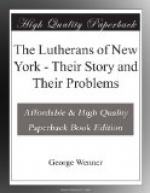But there was a deeper reason for the growth of our church. Ever since the Luther Centennial of 1883 the young people of our churches had begun to understand not only the denominational significance of their church but also something of its inner characteristics and life. In various groups, in Manhattan, Bronx and Brooklyn, they got together and organized English congregations in which an intelligent Lutheran consciousness prevailed.
The Home Mission and Church Exension Boards of the General Synod recognized the importance of the moment in the metropolis of America and gave their effective aid. In Brooklyn and Queens the work received large support from Charles A. Schieren and the Missionary Society with which he co-operated. Sixteen churches were established through the aid of this Society. Schieren was a native of Germany but he early saw the importance of reaching the people in the language which they could best understand. As a citizen he was public spirited and progressive. From 1894 to 1895 he was mayor of Brooklyn.
The pastors of these incipient congregations were men of vision who had been attracted to the work in New York by its difficulty and its opportunity. They came from different seminaries and synodical associations and they had to minister to congregations in which all varieties of the older churches were represented. But they soon learned to cooperate with one another in measures looking to the larger interests of the entire field. Team work became possible. A stimulus was given to the work such as had never before been felt in the Lutheran churches of New York.
A Ministers’ Association, to which all Lutheran pastors of the Metropolitan District, are eligible, was organized in 1904. Its monthly meetings brought about a mutual understanding and fostered a fraternal spirit that have been of great value in the promotion of the general work of the church.
The synod of New York and New England, composed of the English churches of the New York Ministerium was organized in 1902. It found its special mission in planting and rearing English missions in the new sections of the greater city. It has added nine English churches to the roll.
The Synod of New York, a merger of the New York and New Jersey, the Hartwick and the Franckean synods also devoted itself to the special task of caring for the English speaking young people. Under its auspices thirteen new churches have been organized. To the indefatigable labors of its Superintendent of Missions, Dr. Carl Zinssmeister, much credit is due for the success of the work.
The Synod of Missouri, although largely a German body, rivals the other synods in its fostering care of the English work. At least thirteen English congregations in this city have been organized by “Missouri” since the beginning of this century.
The relation of the various boroughs to the growth of the church may be seen from the following figures in which the number of communicants in 1918 is compared with that of 1898.




